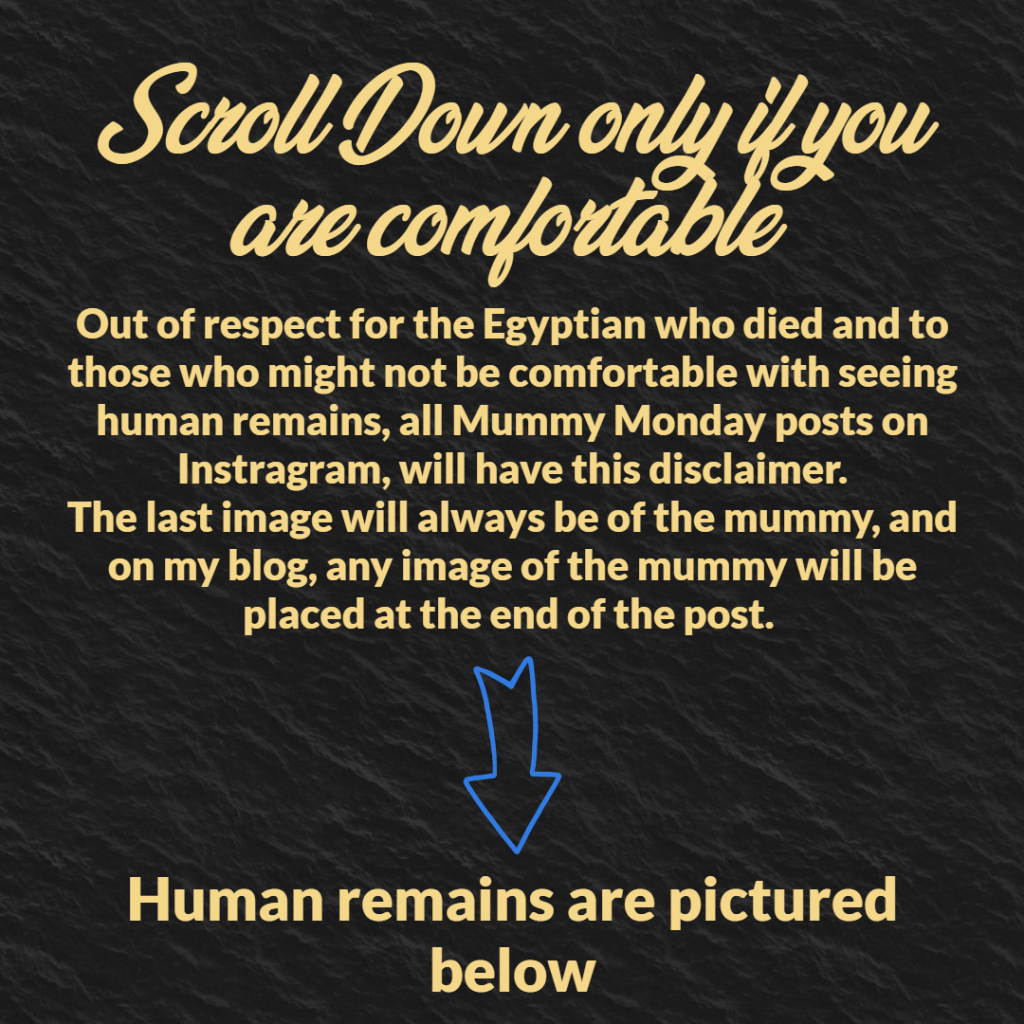This week we are going to take a look at a burial from the Old Kingdom! Let’s look at the mother of King Teti, Sesheshet.
Life

Very little is known about Sesheshet, sometimes known as Sesh. We do know that she was the mother of King Teti, the first pharaoh of the 6th Dynasty of the Old Kingdom. Her husband’s name is unknown, but it unlikely that he was of royal blood. The last king of the 5th Dynasty, Unas, most likely died without an heir. But one of his daughters, Iput, married Teti, who them succeeded his father-in-law. It has been implied that Sesheshet had a significant role in arranging this marriage and thus enabled her son to gain the throne.
Very little is known about Sesheshet, sometimes known as Sesh. We do know that she was the mother of King Teti, the first pharaoh of the 6th Dynasty of the Old Kingdom. Her husband’s name is unknown, but it unlikely that he was of royal blood. The last king of the 5th Dynasty, Unas, most likely died without an heir. But one of his daughters, Iput, married Teti, who them succeeded his father-in-law. It has been implied that Sesheshet had a significant role in arranging this marriage and thus enabled her son to gain the throne.
She is also referred to in the Ebers Papyrus, currently at the University of Leipzig, in Germany. In this papyrus, there was a medical recipe to cure baldness.
“Another remedy to make the hair grow, prepared for Shesh, the mother of his Majesty, The King of Upper and Lower Egypt, Teti the justified.”

It is unclear if this recipe was made because the Queen was losing her hair or if the recipe was created at her request. For those curious, the cure for baldness is apparently, the claw of a dog, the hoof of a donkey and some boiled dates, though it is unclear what you were supposed to do with those ingredients!
For several other Egyptian cures for baldness, click here.
According to Manetho, a Late Egyptian priest who wrote about the history of the Egyptian pharaohs, Teti was murdered by his bodyguards in a harem plot, possibly by the usurper and next pharaoh Userkare. Though there is little evidence to back up this story, some have speculated that Sesheshet would have helped her son against the conspirators, but after her death, they defeated Teti.
Excavation
Again, we know very very little about Sesheshet. But remarkably her tomb and burial have been found.
On November 8th, 2008, the Supreme Council of Antiquties announced that they found Sesheshet’s pyramid in Saqqara. It was a subsidiary pyramid of her son Teti’s complex. The site had been excavated since 2006 and the pyramid was found in September 2008 under 7 meters of sand, a small shrine and mudbrick walls from later periods. The pyramid was not entered until January 2009.

I will note that there is some conflicting data on whose pyramid this was. The Council announced that the pyramid was Sesheshet’s, but there are no inscriptions in the pyramid to prove this to be so. Some other articles mention that there was evidence within the pyramid, but do not elaborate. I believe that Sesheshet is the most likely candidate, as two other pyramids have already been identified as those of Teti’s wives.
Pyramid
The pyramid is now topless (currently 5 meters or 16 feet tall) but was most likely 14 meters or 46 feet tall when complete. It may have actually been Saqqara’s most complete subsidiary pyramid, as many of these were not completed. The base was 22 meters or 72 feet on all sides and the walls sloped at a 51 degree angle. The substructure of the pyramid was 19 meters underground.
Although I could not find a complete consensus from my sources, I believe the pyramid was found next to Teti’s Pyramid and the pyramids of his wives, Iput and Khiut. The other pryamids were found around 100 years ago and in 1994.

The burial chamber was 22 meters long and 4 meters wide and a large granite sarcophagus was found inside. It had no inscriptions and the lid had two pinholes to secure it. The lid may have been around 6 tons (though other sources say the entire sarcophagus was that much). It took five hours for the lid to be lifted by the excavators.
Unfortunately, there was a vertical shaft from the top of the pyramid that was made by tomb robbers, so the excavators were not expecting much. The pyramid was mostly looted, but some treasures lay within the chamber and the sarcophagus.
According to some sources, the following items were found in the tomb: vessels made of alabaster and red clay, tools lacquered in gold, and canopic jars, possibly still holding the organs of the King’s Mother.


Mummy
Within the sarcophagus were the presumed remains of Sesheshet. Although her body may have been properly mummified when she died, the looters and time had tainted the body. A skull, legs, and pelvis were found, with bits of linen. Looters most likely took off the linen in search for gold or precious stone amulets or jewelry.
Though they were not able to take everything, as gold was found that would have covered the fingers of the deceased. If only I had a picture!
I know this wasn’t the most interesting Mummy Monday, but I wanted to try and move away from the later portion of Egyptian history, when the majority of the preserved mummies date to.
Sources
https://en.wikipedia.org/wiki/Sesheshet
http://www.guardians.net/hawass/Press%20Releases/queens_pyramid_saqqara_11-08.htm
https://grahamhancock.com/phorum/read.php?1,308190
https://www.haaretz.com/1.5034161
http://judithweingarten.blogspot.com/2009/01/queens-are-magic.html
https://www.smithsonianmag.com/history/the-tomb-of-queen-sesheshet-49733615/
https://freddysetiawan.wordpress.com/2009/01/27/queens-mummy-found-in-4300-year-old-pyramid/
Photo Sources
Photos of the excavation – Mohamed Magahed
Picture of Teti Pyramid – Wikimedia Commons (Wknight94)
Teti Pyramid plan – Wikimedia Commons (Malyszkz)
Map of area – http://www.touregypt.net/sakkara.htm
Other Map – http://www.athenapub.com/aria1/_Egypt/DEpic/PE-SaqqaraNTomb1c.html
Ebers Papyrus, Mummy photos – Judith Weingarten Blog





